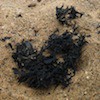
 Plastics manufacturers tend to promote recycling as the holy grail for waste management. As more cities aim to divert more materials from landfills for good reason, more recycled material gets processed and needs to find a second life. Some materials can be made directly into the same products they came from while other materials are 'down cycled' into different products.
Plastics manufacturers tend to promote recycling as the holy grail for waste management. As more cities aim to divert more materials from landfills for good reason, more recycled material gets processed and needs to find a second life. Some materials can be made directly into the same products they came from while other materials are 'down cycled' into different products.
Today's focus is on one of those down-cycled products: outdoor playground surfaces. While I am not an expert on them, I have been doing a bit of research since finding pieces of an old one at a beach cleanup. One of my local beaches, Marina Park in Ventura, recently renovated their playground by replacing the surface and adding new features.
I have young daughters at home so I was excited at the prospect of a new park for them to play at. Everything seemed to go smooth with construction and it opened a couple of months back. The Surfrider Ventura Chapter hosted a cleanup there on Sunday and while wandering around I was a bit shocked to see what appeared to be pieces of the old playground that were left behind.
There were lots of little pieces from the size of a quarter up to a small apple. Ok, maybe some of those were too small to clean up. Then I came across a piece that was about four feet long by two feet wide and 20+ pounds. Pretty hard to miss that.
 Taking a closer look, it was a rubbery material that appeared to be shredded then compressed. It would break off into pieces but the smaller shred were hard to pull apart. After some online research it appears that most of these surfaces are a mix of recycled rubber and plastics - ending up in a material that won't biodegrade in our lifetimes.
Taking a closer look, it was a rubbery material that appeared to be shredded then compressed. It would break off into pieces but the smaller shred were hard to pull apart. After some online research it appears that most of these surfaces are a mix of recycled rubber and plastics - ending up in a material that won't biodegrade in our lifetimes.
So, if a product can only be recycled once is it really beneficial? I'm not aware of any type of recycling program for the playground surface so once used it's likely to go to a landfill. That is, if you can capture all of it. Recycled products are a step in the right direction but there need to be an end-of life recycling program readily available for them to be closed-loop and successful.
So what is the answer? Let's pursue more source reductions to help turn off the tap of plastic heading to the ocean. Plastic checkout bag bans and extended producer responsibility (EPR) are gaining momentum and need your support.
PS- I usually like to use the term 'plastic pollution' when appropriate but chose 'marine debris' in the title of this blog post since the surface included recycled rubber content. If you happen to have more info of the surface material, please send it our way.